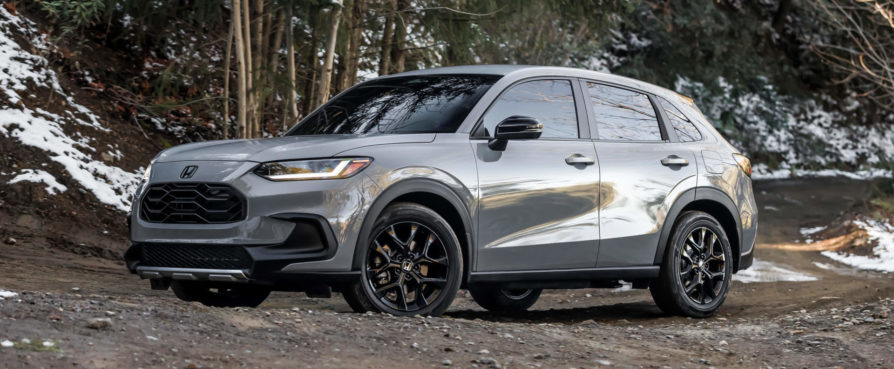2023 Honda HR-V
The Honda HR-V may have arrived a little late to the subcompact crossover party, but, with Honda’s wealth of knowledge on how to load lots of space and features into small packages, when it finally did arrive for 2016, it instantly became a top pick among small utes.
What Honda has done with the all-new 2nd generation 2023 Honda HR-V is essentially replaced the awkward-looking Fit-based first gen effort, with a more traditional SUV shape that has much more in common with the larger but still compact CR-V.
But, as is usually the case when things go more mainstream, the HR-V has lost a few things along the way that made it unique. Primarily, its eminently practical rear magic seat is no more, being replaced by a more familiar split folding design.
We’re less saddened by the rear door handles moving from the pillars down to a more familiar position on the doors. Also our entire staff agrees it’s a much better-looking design, though the rounded face keeps the overall vibe playful.
Now actually based on the Civic, this HR-V is 9.4–inches longer and wider than before. That, along with its more SUV-like shape, generates an extended roofline with more practical cargo space. But, there’s still enough rear glass rake to give the HR-V a hatchback feel. At 24.4 cubic-ft., cargo room behind the second row split-bench is up over last year, and among best in class.
Now, while it may look more like an SUV, you actually sit lower than before inside. Still, there’s a much nicer interior to look at, with a more functional layout. Materials with honeycomb accents, and French stitching, help HR-V truly feel a step above the price point it’s playing in.
Tech was not exactly cutting edge in the first HR-V. It is a much different scene now. There’s even a nice clear digital gauge panel that includes an actual speedometer with needle, not the customary Honda digital readout.
On top of the dash is either a 7-inch touchscreen as standard. Our test EX-L came with a 9-inch display with wireless Apple CarPlay and Android Auto connectivity. There are plenty of easy access USBs, and helpful pass thru storage in the console too. Top EX-L also adds wireless phone charging, power moonroof, leather trimmed seats, dual zone climate controls, ambient lighting, and parking sensors front and rear.
Front seats are wide and comfy, and while the rear seats no longer perform magic tricks, your mother-in-law will appreciate that they are now much more comfortable than before.
Under-hood, is the Civic’s naturally aspirated 2.0-liter I4 with 17–more horsepower than the previous HR-V’s 1.8-liter. However, 158-horsepower and 138 lb-ft. of torque are not going to drum up too much excitement. Transmission is also the Civic’s CVT, but with the ability to add all-wheel-drive.
The HR-v now also sports the Civic’s multi-link independent rear suspension. It makes for noticeable improvement over the previous HR-V’s torsion-beam setup, with better composure and less body roll on all surfaces. The ride is also far more civilized and an expansive greenhouse gives great visibility all around.
For our complete road test of the 2022 Honda HR-V, be sure to catch MotorWeek episode #4203 that begins airing on PBS September 23, 2022. For a listing of the PBS public television stations that broadcast MotorWeek, go to motorweek.org and click the “About the Show” tab at the top. You can also watch weekly episodes of MotorWeek on our cable partner MAVTV with new episodes airing each Saturday at 7:30 PM. Check their entire schedule at MAVTV.com. MotorWeek can also be streamed in its entirety on PBS.org/MotorWeek, as well as on PBS Living, a part of Amazon Prime Video. Road Test videos are also available at motorweek.org and on youtube.com/motorweek.
There may be more Civic and less Fit in this 2023 Honda HR-V, but that actually makes it a better fit for most small families and young “couples on the go” who want a small utility vehicle to live their young active lifestyle lives to the fullest.






